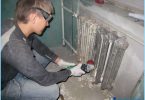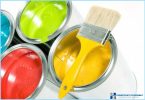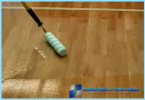The contents
Mastic is a fairly strong binder material. With its help it is possible to perform sealing of walls, ceilings, floors, Windows, do the tiling and waterproofing. Mastic is produced in liquid or pasty form, and the form of a thick glutinous mass. In the modern market is often found the finished powder composition, which can only be diluted with water before direct application.
The types of bitumen composition ↑
All of the polishes have high adhesive properties and most of them are similar in composition. To select the type of material should first evaluate the surface and type of work.
Bitumen mastic – is a modern and easy to work waterproofing material, which is widely used in roofing, hydro – and vapor barrier, as well as to treat the floors. This type consists of bitumen binder, herbicides, preservatives and fillers.
At asphalt mastic there are a lot of advantages, namely:
- elasticity, good rasteryannosti and recoverability;
- high temperature resistance;
- durability and reliability.
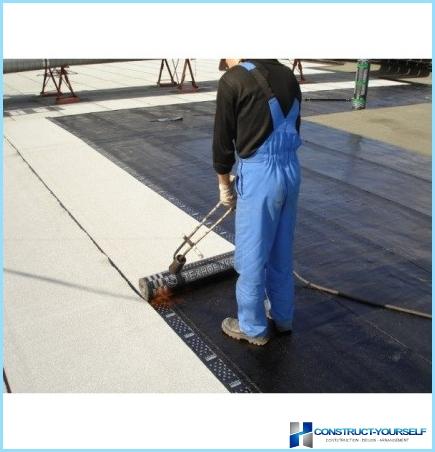
Waterproofing. Is created on the basis of bitumen mastic in the form of a semi-fluid paste ready for use. It is composed of various mineralogical, bitumen emulsion, special additives based on synthetic resins.
This material has all the characteristics of the asphalt mastic, but its mechanical strength is much higher. The material used for waterproofing walls, roofs, foundations, balconies, chimneys, cement or metallic gutters.
Cold asphalt kukersolnoj. Made from lacquer kukersol and solution of shale oil. To improve the characteristics, the composition of bituminous mastics introduced latex emulsions based on dispersed rubber. Such materials are called bitumen-latex and used for attaching roof coverings.
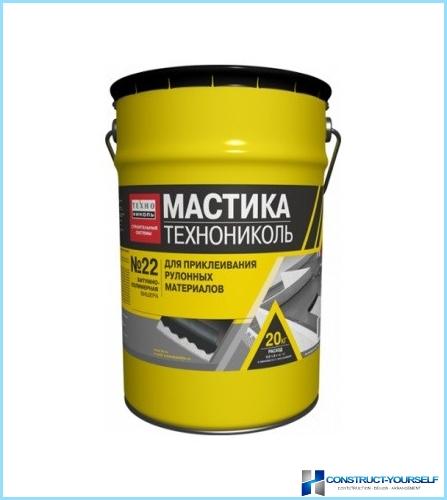
Roofing. Also called liquid roof and can be used as an independent roofing material. Mastic is produced in the form of a viscous homogeneous mass, which is applied to the surface by spray or brush.
When using roofing mastic remains of joints and seams, thus creating a continuous, monolithic coating. This insulating material may be coated steel, roofing material, concrete and other materials. Roofing mastic repair the old roof, sealing of joints and seams.
A coating of this material has the following advantages:
- high strength;
- resistance to atmospheric influences;
- resistance to sunlight and temperature fluctuations;
- elasticity;
- corrosion resistance;
- low weight.
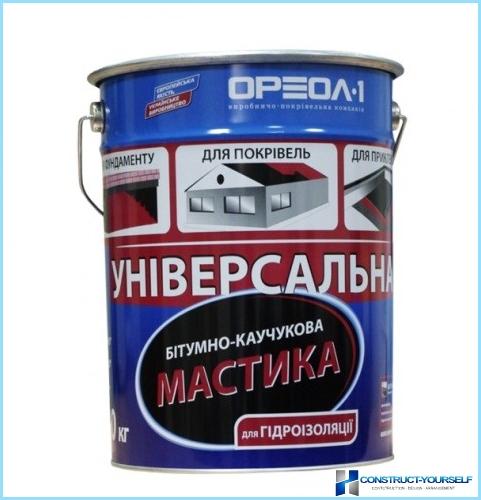
Bitumen-rubber. Available in the form of a homogeneous mass of black colour is ready for use. The composition includes a mixture of varieties of petroleum bitumen, synthetic rubber, crumb rubber fines, mineral fillers, natural resin acids, the target additives and various solvents.
This material is quite flexible, has good heat resistance and withstands temperature extremes of -30?C – +130?C. it is Also used for repair of mastic roofs and performs the function of the adhesive composition when using rolled roofing materials and to create a waterproofing design and construction.
Polymer mastic. This quick-drying environmentally friendly bituminous material water based, enhanced with special polymers. Used for waterproofing waterproofing of underground structures, sealing of sewers and wells. After application to the surface of the sealant forms a waterproof rubber membrane, which has a very long life.
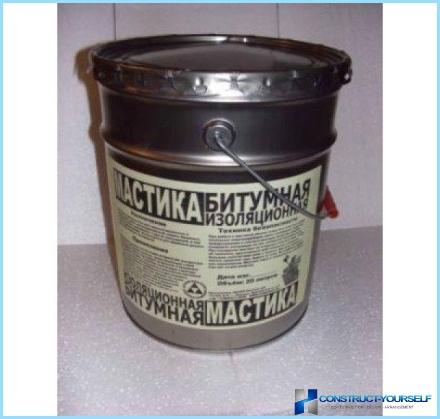
Sealing mastic. Made in a thick white mass, used for sealing joints, gaps, cracks and joints in concrete and reinforced concrete structures. It has excellent adhesion to metal, wood and concrete. After complete drying of the mastic it can be treated with paint coatings.
Refractory. This mastic is made in the form of a viscous plastic mass of gray. Binder is made of inorganic substances with the addition of silicate additives and mineral filler. This mastic is used for insulation of furnaces and flues and can withstand temperatures up to +1600?C.
Natertaya sealing mastic. Homogeneous viscous mass consisting of several types of rubber, fillers and plasticizers. Sold in blocks and is used to seal the exterior walls, sealing of door and window blocks in places of an adjunction to the wall.
Universal. This is a homogeneous mass of bitumen and various fillers. Mastic is intended for carrying out waterproofing and roofing works, creating corrosion protection of various structures and pipelines. Also through the universal mastic to glue different materials.
Noise insulation. Sprayed weight with good vibration dampening and sound insulating properties, produced on the basis of water dispersion of synthetic resins with the addition of protivovospalitelnym components.
Mastic butyl rubber. This material is made from environmentally-friendly components and are not affected by putrefactive processes. Mastic is widely used to create isolation of ventilation systems.
Acrylic waterproofing. The most popular material that creates when applied to the surface of the waterproof film and protects coating against mold, dampness and rust. Has high strength, ease of use and is used only for sealing indoors.
Epoxy. This type of material is in the form of a dense mass of bituminous resin dissolved in an organic diluent, a dry pigment and filler with a plasticizer. Before the application of the mastic added the hardener. Thanks to this material get a very durable and abrasion resistant floors, production plants, and it is also used as adhesive means.
Two-component polyurethane. Liquid mass of white, odorless and forming after the application of a strong elastic coating. Two-component polyurethane sealant used for waterproofing of drinking water reservoirs, water pipes and high humidity areas.
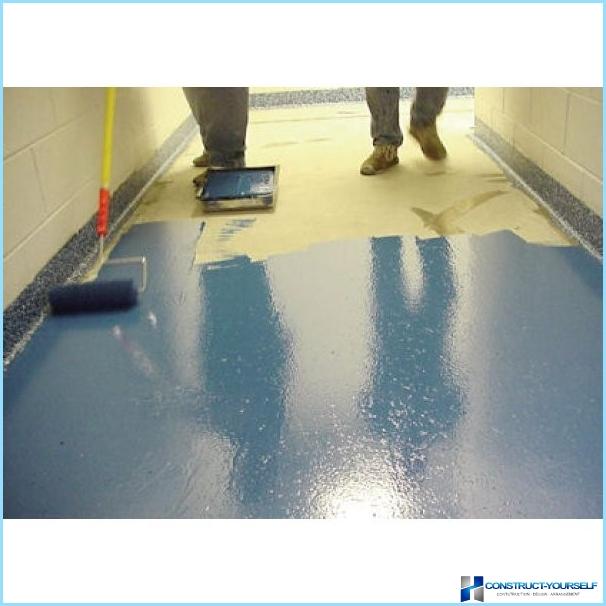
Apply the mastic ↑
Asphalt mastic can be applied manually with a brush or roller, and mechanical, with the use of special air sprayer.
Both of these method of application are quite sophisticated and provide a good opportunity to produce work related to the roofing fairly easily and quickly, regardless of the angle of slope of the roof. It is especially noticeable when the device roofs, with a large number of attachments and different elements.
During coating on the roof of the mines, pipes, supporting structures and so on rolled materials need to spend a lot of time and effort to cutting pieces of material are sometimes very complex configuration, while the mastic in this case allows to perform the coating in exactly the same way as on smooth surfaces. Therefore, putty in this regard have certain advantages over rolled materials.
Consumption of bitumen mastic for 1m? ↑
Impossible to plan work and make estimates without knowing how much material is needed to handle 1m?. To determine the flow of mastic, it is easiest to look at the label, and if it is not the data, then at least spell the recommended minimum of material for applying a single layer. Therefore, it is easy to independently calculate the amount of material required. Basically mastic 30-70% are composed of volatile solvents, which means exactly the same percentage of shrinkage of the bitumen composition after application.
The average material consumption per 1m?
| Waterproofing basement | 2-4 kg/mTwo |
| Roofing | 3,5-6 kg/mTwo |
| Bonding of roofing material | 1-2 kg/mTwo |
Safety ↑
Since many of the solvents used to create a mastic, quite toxic and very flammable, when working with such materials should adhere to certain security measures. Bitumen mastic should be prepared in a room with good supply and exhaust ventilation system, in extreme cases, in open air,.
When working with bitumen mastic outdoors be sure to use safety glasses and a respirator, and in enclosed spaces – gas masks. After each hour of work in confined spaces to make a break for 15-20 minutes and spend it outdoors.
To prevent increased fogging mechanized way of working with the mastic, it is necessary to keep the sprayer perpendicular to the surface and no further than 0.5 meters from her. After working with these materials should be good to wipe hands, then wash them with soap and warm water.
Work, cause sparks or requiring the use of open flames must be performed at a distance of not less than 25 meters from the place of use of the bitumen composition. In the premises where the work is done with mastic requires the use of electrical equipment only explosion-proof type.


